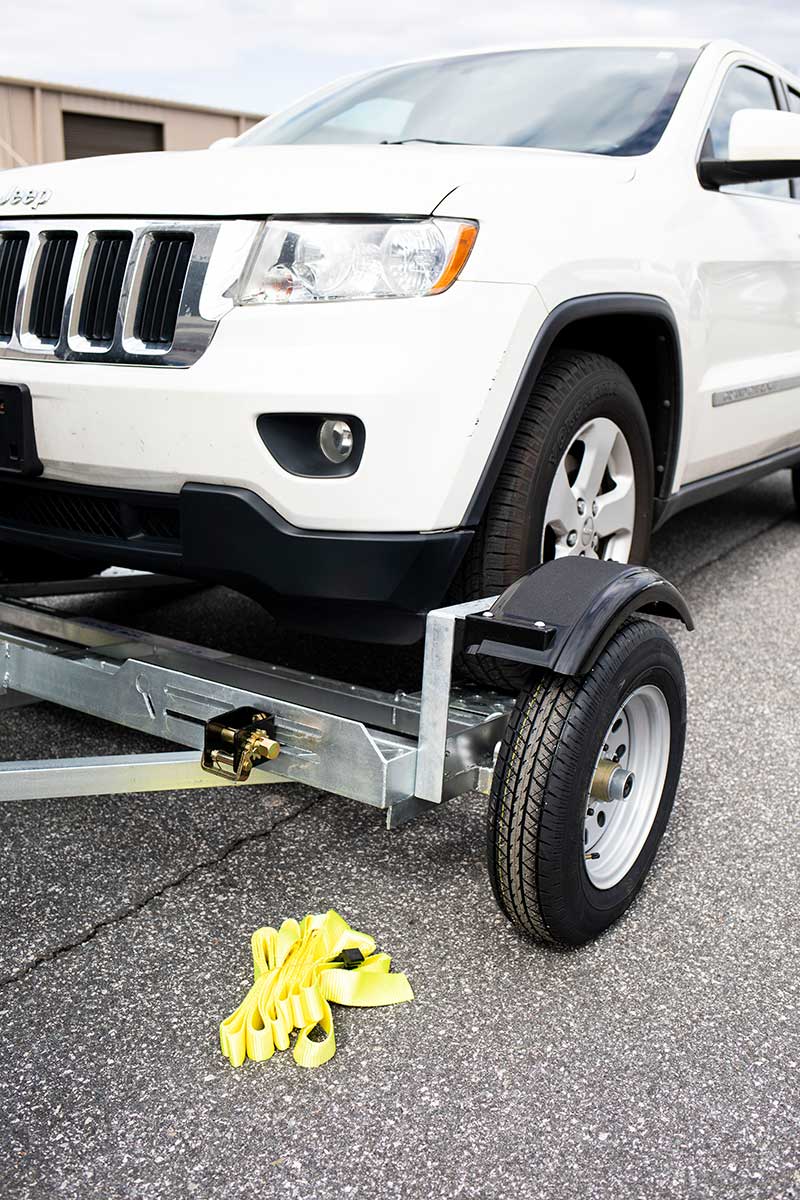
How to Load A Car on A Tow Dolly
For road trips, most RV owners opt to include an auxiliary vehicle. If you’ve decided to travel by RV for your next getaway, it’s crucial to know how to load a car on a tow dolly.
After all, towing your car won’t happen if you cannot properly load it onto a tow dolly. The process of loading a car onto a dolly is straightforward. You do not have to be an expert and we’re more than happy to teach you how to load your car on your car tow dolly. We’re certain you’ll have it down to a matter of minutes with a few practices.
Don’t Overlook These Factors
A number of factors will influence your car’s ability to be loaded on and subsequently hauled by a tow dolly.
• Your car’s make and model
The make of your vehicle will affect how easy it becomes to load your vehicle and hit the road.
A car tow dolly is primarily suited for vehicles with front-wheel drive transmissions. Such a model requires no special steps when loading on a tow dolly. With a front-wheel drive, power from the engine goes to the front wheels alone.
Therefore, you won’t have to disconnect drive shafts. After all, it’s just the front wheels that’ll get on the tow dolly. The process makes for simple loading or unloading of your front-wheel-drive car. Better still, no mileage will accumulate on your car’s odometer.
• Your car’s weight
Knowing the weight of the vehicle being towed is fundamental. In any case, what’s important is that your tow vehicle should be heavier than your vehicle-in-tow. It is suggested that it should be 750 pounds heavier at least. If your car weight exceeds that of what the dolly can tow, towing might become dangerous without additional brakes and other safety equipment.
It’s prudent to research if your vehicle is suitable to be dolly towed. Be sure to peruse your car owner’s manual as well prior to loading your car on a tow dolly.
• Type of dolly
Two types of tow dollies are prevalent today. They are the mounted front wheels dolly and central pivot dolly.
• The mounted front wheels dolly
The mounted front wheels dolly possesses wheels which act similarly to the front wheels of your car. These turn on kingpins. Plus, they allow your car to move on a pivot that sits between the trailer wheels. This type is safer to use. During twists and turns, they minimize the chances of your vehicle-in-tow hitting the rear end of your RV. Examples include:
- EZE TOW Car Tow Dolly
- Kar Kaddy SS Tow Dolly
• The center pivot RV dolly
This type of dolly is quite similar to the mounted front wheels dolly. This type of dolly sports fixed trailer wheels. Again, the source of pivot that allows your car to track around corners lies in the center of the pivot. The positioning of the pivot, however, may cause your vehicle-in-tow to sway around during turns. Examples include:
- Stehl Tow Dolly
- Master Tow Dolly
- Demco Tow It 2 Tow Dolly
- American Car Dolly
- Ultra Tow Dolly
Connecting Your Tow Dolly
If you’ve got your desired choice of tow dolly, all you need to do is to attach it to your RV. Follow our complete guide to assist you in securing your tow dolly to your RV. After everything is attached, you’re ready to load your car onto your tow dolly.
Tips Before You Load
Before you load your car, you’d want to keep these few tips in mind. That way, you’ll be doing what’s best for your car, and your dolly.
1. Again, only load a front-wheel-drive vehicle
- Make sure your vehicle is ready for loading.
- It’s good to check the vehicle tires before loading your car, to make sure they have enough air for the road. You don’t want to be towing the car and get a flat tire, because you didn’t check the pressure.
2. Check your tow dolly before loading your car.
- Double-check that the tires are set, the dolly is correctly attached, and that the pins and safety chains are securely fastened.
3. Make sure the back of your vehicle is empty.
- If you place too much weight in the back of your vehicle, you risk ‘whipping’ your car around on the road. ‘Whipping’ is when your car moves from side to side rapidly, because of an improper weight balance.
4. Have all the proper accessories ready to go.
- Have your tire straps, brake lights, and other accessories on standby for once you’re done loading your car.
How to Load Your Car onto A Tow Dolly
Once all the proper set up has been done, it’s time to load your car onto the tow dolly! Here are all the essential steps you need to take to get your car fully loaded onto your tow dolly.
- Park your car and tow dolly on a flat, firm surface, and have them aligned with each other
- Extend the ramps of your tow dolly, and lay the tire straps flat on the ground
- Center your vehicle with the dolly
- Slowly drive your car up the ramp, so it locks securely on the ramp
- Make sure you drive off the front of the dolly.
- If you have a locking column it must be left unlocked to use the “ EZE-TOW “ Car Tow Dolly.
- Park your car, and be sure to apply the parking brake
- Once you’ve loaded your vehicle, it’s time to secure your car – you can read the instructions on how to strap down a car tow dolly easily and efficiently
- After following all the proper steps, make sure your car is in park and that the brake has been released. Your steering column must be unlocked.
- Drive your RV around the block to ensure everything is set to go.
Once everything looks and feels secure, it’s time to hit the road! Just remember when you’re towing a vehicle to check your tire straps between stops.
Once you’re ready for your next road trip, take the time to explore What Terrain can an RV Tow Dolly Cover and see What Cars can be Towed on A Tow Dolly.



Pingback: Do You Need A Tow Dolly Registration? – CARTOWDOLLY